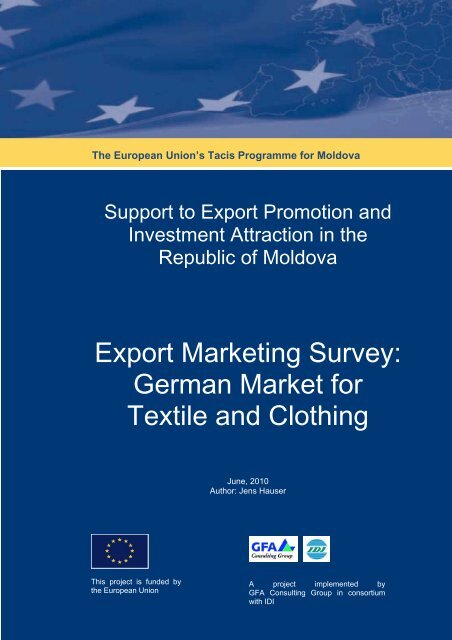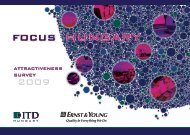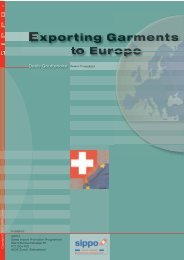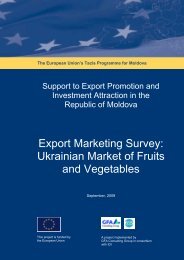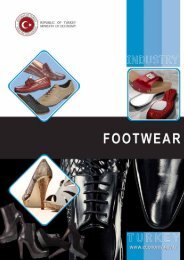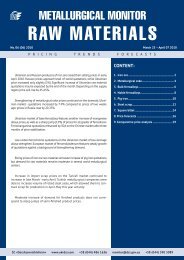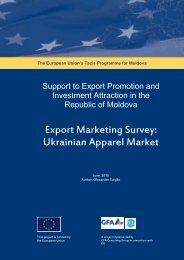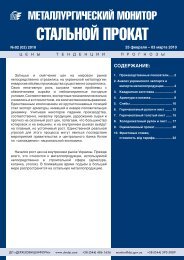Export Marketing Survey: German Market for Textile and Clothing
Export Marketing Survey: German Market for Textile and Clothing
Export Marketing Survey: German Market for Textile and Clothing
Create successful ePaper yourself
Turn your PDF publications into a flip-book with our unique Google optimized e-Paper software.
The European Union’s Tacis Programme <strong>for</strong> Moldova<br />
Support to <strong>Export</strong> Promotion <strong>and</strong><br />
Investment Attraction in the<br />
Republic of Moldova<br />
<strong>Export</strong> <strong><strong>Market</strong>ing</strong> <strong>Survey</strong>:<br />
<strong>German</strong> <strong>Market</strong> <strong>for</strong><br />
<strong>Textile</strong> <strong>and</strong> <strong>Clothing</strong><br />
June, 2010<br />
Author: Jens Hauser<br />
This project is funded by<br />
the European Union<br />
A project implemented by<br />
GFA Consulting Group in consortium<br />
with IDI
This Project is financed<br />
by the European Union<br />
Support to <strong>Export</strong> Promotion<br />
<strong>and</strong> Investment Attraction in<br />
the Republic of Moldova<br />
EuropeAid/126810/C/SER/MD<br />
This Project is implemented by a<br />
Consortium led by GFA<br />
Consulting Group<br />
Table of Contents<br />
1 INTRODUCTION AND METHODOLOGY I<br />
2 MAIN FINDINGS – EXECUTIVE SUMMARY III<br />
3 OVERVIEW OF THE GERMAN TEXTILE AND<br />
CLOTHING MARKET<br />
V<br />
3.1 PRODUCTION v<br />
3.2 CONSUMPTION iii<br />
3.3 PRICES v<br />
3.4 TRADE - EXPORT <strong>and</strong> IMPORT vi<br />
4 MARKET ACTORS AND ENTRY IX<br />
4.1 Trade Channels <strong>and</strong> <strong>Market</strong> Actors ix<br />
4.2 Retail Structure <strong>and</strong> Trends x<br />
4.3 MARKET ACCESS REQUIREMENTS xi<br />
5 EXPORT OPPORTUNITIES AND OBSTACLES XIII
This Project is financed<br />
by the European Union<br />
Support to <strong>Export</strong> Promotion<br />
<strong>and</strong> Investment Attraction in<br />
the Republic of Moldova<br />
EuropeAid/126810/C/SER/MD<br />
This Project is implemented by a<br />
Consortium led by GFA<br />
Consulting Group<br />
1 INTRODUCTION AND<br />
METHODOLOGY<br />
The following market survey has been produced within the framework of the<br />
European Commission project “Support to <strong>Export</strong> Promotion <strong>and</strong> Investment<br />
Attraction in the Republic of Moldova”. The project is implemented by a GFA<br />
Consulting Group led consortium. The project intervention areas are:<br />
Component 1<br />
Support to Ministry of Economy <strong>and</strong> Trade <strong>and</strong><br />
its agencies in coordinating <strong>and</strong> improving<br />
Moldova’s export <strong>and</strong> investment promotion<br />
systems<br />
Component 3<br />
Support to Moldovan enterprises in accessing<br />
export development financing<br />
Component 5<br />
Investment Promotion<br />
Component 2<br />
Support to Ministry of Agriculture <strong>and</strong> Food<br />
Industries in enhancing its system of testing<br />
laboratories<br />
Component 4<br />
<strong>Export</strong> promotion<br />
Methodology<br />
The market survey provides Moldovan producers of textile products (clothing,<br />
outwear) with an overview on the <strong>German</strong> market <strong>for</strong> the respective products.<br />
Furthermore trade channels <strong>and</strong> market access requirements are outlined as well<br />
as major market actors in <strong>German</strong>y. In addition, the market survey findings are<br />
matched to the Moldovan production <strong>and</strong> export capacity in order to give<br />
recommendations on export opportunities <strong>and</strong> obstacles.<br />
The survey starts with a general description of the <strong>German</strong> apparel market,<br />
outlining production <strong>and</strong> consumption of outerwear, as well as trends. The<br />
market description intends to provide a sectoral overview. At the end of the<br />
description the pricing <strong>and</strong> trade in the apparel sector will be highlighted.<br />
In the following trade channels <strong>and</strong> practice, as well as market access<br />
requirements will be presented. This chapter aims to provide Moldovan clothing<br />
producers with in<strong>for</strong>mation on the common trade practice <strong>and</strong> logistical<br />
requirements of importers, as well as legal <strong>and</strong> technical requirements <strong>for</strong>mulated<br />
by EU <strong>and</strong> <strong>German</strong> policy makers.<br />
Finally, using the in<strong>for</strong>mation presented in the previous chapters, as well as<br />
in<strong>for</strong>mation on the Moldovan garment sector, opportunities <strong>and</strong> obstacles <strong>for</strong><br />
Moldovan producers will be <strong>for</strong>mulated.<br />
The in<strong>for</strong>mation presented in this market study is based on quantitative <strong>and</strong><br />
qualitative data, attained via desk research <strong>and</strong> interviews. Quantitative data<br />
sources include CBI (Centre <strong>for</strong> Promoting Imports from Developing Countries),<br />
Statistisches Bundesamt, EUROSTAT, as well as data from the <strong>German</strong> apparel<br />
associations. Interviews with <strong>German</strong> market actors have been the source <strong>for</strong> the<br />
qualitative data.<br />
1
This Project is financed<br />
by the European Union<br />
Support to <strong>Export</strong> Promotion<br />
<strong>and</strong> Investment Attraction in<br />
the Republic of Moldova<br />
EuropeAid/126810/C/SER/MD<br />
This Project is implemented by a<br />
Consortium led by GFA<br />
Consulting Group<br />
2
This Project is financed<br />
by the European Union<br />
Support to <strong>Export</strong> Promotion<br />
<strong>and</strong> Investment Attraction in<br />
the Republic of Moldova<br />
EuropeAid/126810/C/SER/MD<br />
This Project is implemented by a<br />
Consortium led by GFA<br />
Consulting Group<br />
2 MAIN FINDINGS – EXECUTIVE<br />
SUMMARY<br />
Production<br />
Consumption<br />
Import <strong>and</strong> <strong>Export</strong><br />
<strong>German</strong>y is the largest clothing <strong>and</strong> outerwear market in the EU with a total<br />
consumption of about 51 billion € in 2009. The <strong>German</strong> clothing industry is the<br />
second largest consumer industry, only excelled by the food <strong>and</strong> beverage<br />
industry.<br />
<strong>German</strong>y is the 3 rd largest producer of clothing in the EU. For more than 30 years<br />
the <strong>German</strong> clothing sector is facing a far‐reaching structural change, mostly due<br />
to low‐cost competition from Asia. As a consequence most <strong>German</strong> manufactures<br />
have developed an outsourcing policy as part of their restructuring process. The<br />
clothing production has been relocate to countries with low overall manufacturing<br />
costs, while central functions like design, procurement <strong>and</strong> marketing are still<br />
based in <strong>German</strong>y. Basically all <strong>German</strong> clothing manufactures have more or less<br />
turned into creative <strong>and</strong> flexible trading enterprises with external job order<br />
production. At the same time the <strong>German</strong> clothing companies orientated more<br />
towards <strong>for</strong>eign markets, nowadays having an export share of about 40%.<br />
The trend in production goes towards the purchase of finished goods, while inhouse<br />
<strong>and</strong> job order production abroad is getting less. The concept of Fast Fashion<br />
is a clear trend in the production of higher quality clothing. The concept implies<br />
shorter intervals between collections / fashion lines, which in turn means that<br />
smaller, quickly changing lots of clothes are produced.<br />
<strong>German</strong>s spent less than 5% of their disposable income on clothing. <strong>German</strong>y has<br />
an average price level <strong>for</strong> clothing in comparison with other EU countries. The<br />
market <strong>for</strong> clothing is becoming more mature <strong>and</strong> saturated, with abundance of<br />
producers <strong>and</strong> retailers offering fashionable clothes.<br />
<strong>German</strong> consumers are price sensitive <strong>and</strong> are mindful of a good price‐quality<br />
ratio. Furthermore there is a clear tendency towards individualisation of<br />
consumption, leading to differentiated customer request.<br />
The overall development of the market reflects the growing disparity between the<br />
different economic strata of <strong>German</strong> society, <strong>and</strong> the increasing number of poor<br />
<strong>and</strong> relatively poor <strong>German</strong> residents. Thus many <strong>German</strong> consumers with lower<br />
incomes seek low‐price clothes in a steadily growing discount sector. On the other<br />
h<strong>and</strong>, quality <strong>and</strong> convenience will become more important, <strong>and</strong> the youthful<br />
outlook of the older consumers will strengthen designer <strong>and</strong> sports labels.<br />
The men’s wear market is expected to become the most dynamic, driven by the<br />
increasing number of men who are fashion‐conscious.<br />
<strong>German</strong>y is the largest importer of clothing in the EU, importing outerwear worth<br />
18 billion € in 2007. Imports account <strong>for</strong> 90% of all outerwear sold in <strong>German</strong>y.<br />
67% of all imports derive from countries outside the EU. Leading exporters to<br />
<strong>German</strong>y are China <strong>and</strong> Turkey. Import prices are under pressure <strong>and</strong> declined<br />
from 2005 to 2007. A further decrease is expected.<br />
<strong>German</strong>y is 4th largest exporter in the world, which derives from the fact that<br />
<strong>German</strong> apparel producers, due to their strong br<strong>and</strong>s in the upper market <strong>and</strong><br />
premium segments, successfully penetrated <strong>for</strong>eign markets. This<br />
internationalisation (see also chapter on production) is documented by the fact<br />
3
This Project is financed<br />
by the European Union<br />
Support to <strong>Export</strong> Promotion<br />
<strong>and</strong> Investment Attraction in<br />
the Republic of Moldova<br />
EuropeAid/126810/C/SER/MD<br />
This Project is implemented by a<br />
Consortium led by GFA<br />
Consulting Group<br />
<strong>Market</strong> actors <strong>and</strong><br />
retail<br />
<strong>Market</strong> access<br />
requirements<br />
Moldovan export<br />
opportunities <strong>and</strong><br />
constraints<br />
that the clothing export quota has increased from 10% in 1970 to 44% nowadays.<br />
<strong>German</strong> apparel br<strong>and</strong>s, in particular, have a strong potential in the growing<br />
markets such as Asia or Eastern Europe. <strong>Export</strong>s by <strong>German</strong>y include to a big<br />
extends so called re‐exports – imported products, which are exported to other<br />
countries, mainly EU. It is estimated that about 35% of <strong>German</strong> clothing imports<br />
are re‐exported.<br />
The traditional functions of the different market actors are changing. There is the<br />
general trend of integration in the value chain, which means:<br />
• Forward Integration: more <strong>and</strong> more manufactures open their own br<strong>and</strong><br />
stores (mono‐label) in order to control the point of sale (higher margins,<br />
better knowledge of consumer dem<strong>and</strong>)<br />
• Backward Integration: retailers set‐up their own design departments <strong>and</strong><br />
source supply with own buying departments or agents<br />
With regard to the retail business textile discounters <strong>and</strong> the non‐specialists<br />
(hypermarkets with strong non‐food component) as well as mono‐label stores<br />
have shown a remarkable growth. Also globally operating apparel retail chains like<br />
H&M or Zara have enlarged their market share. In turn the <strong>for</strong>merly strong<br />
independent retailers as well as the department stores have declined strongly.<br />
There are legislative (set by the EU <strong>and</strong> national government) <strong>and</strong> non‐legislative<br />
(set by the trading partner) market access requirements. With regard to<br />
outerwear these requirements are based on environmental, consumer health <strong>and</strong><br />
safety, as well as on social concerns. There is no quality st<strong>and</strong>ard <strong>for</strong> clothing.<br />
Opportunities <strong>for</strong> Moldova include:<br />
• Proximity to EU market which allows to benefit from the Fast Fashion trend<br />
• Upgrading within the textile value chain, using income <strong>and</strong> contacts gained<br />
from contract work: from CMT to value added production<br />
• Explore niche markets, e.g. work with own agents on commission<br />
Obstacles Moldova face:<br />
• Limited investment capacity to upgrade production<br />
• Limitation of labour <strong>for</strong>ce <strong>and</strong> absence of design capacity<br />
• Missing business skills <strong>and</strong> contacts (e.g. sourcing) to upgrade within the<br />
value chain<br />
• Lack of sector support structure: efficient association, fashion centre <strong>and</strong><br />
competence centre<br />
4
This Project is financed<br />
by the European Union<br />
Support to <strong>Export</strong> Promotion<br />
<strong>and</strong> Investment Attraction in<br />
the Republic of Moldova<br />
EuropeAid/126810/C/SER/MD<br />
This Project is implemented by a<br />
Consortium led by GFA<br />
Consulting Group<br />
3 OVERVIEW OF THE GERMAN<br />
TEXTILE AND CLOTHING<br />
MARKET<br />
The following pages provide an overview of the <strong>German</strong> market <strong>for</strong> textile <strong>and</strong><br />
apparel, focussing on clothing. The pattern <strong>and</strong> trends in consumption are<br />
outlined, as well as the business <strong>and</strong> strategies of the <strong>German</strong> clothing companies.<br />
3.1 PRODUCTION<br />
Outline of the<br />
textile <strong>and</strong><br />
clothing sector<br />
The <strong>German</strong> textile <strong>and</strong> clothing industry, characterised by mid‐sized companies,<br />
is the second largest consumer goods industry only excelled by the food <strong>and</strong><br />
beverage industry. The turnover amounted to 19.2 billion € in 2008, with textile<br />
production accounting <strong>for</strong> approximately 58%, <strong>and</strong> clothing <strong>for</strong> 42% of the total.<br />
Basic Data of the <strong>German</strong> <strong>Textile</strong> & <strong>Clothing</strong> Industry<br />
Turnover<br />
(in Mio. €)<br />
Production<br />
(in Mio. €)<br />
Imports<br />
(in Mio. €)<br />
<strong>Export</strong>s<br />
(in Mio. €)<br />
Employees<br />
(number)<br />
2000 2006 2007 2008 Change<br />
2007 to 2008<br />
26.409 19.742 19.949 19.169 ‐3,9%<br />
16.375 12.820 12.863 12.213 ‐5,1%<br />
31.730 30.864 31.721 30.398 ‐4,2%<br />
18.943 21.395 22.618 21.833 ‐3,5%<br />
185.195 104.299 102.020 97.026 ‐4,9%<br />
Source: <strong>German</strong> Ministry of Economy, “Branchenfokus Textil und Bekleidung”, 2010<br />
In 2008 both, the textile <strong>and</strong> the clothing industry, recorded a decrease in<br />
production, turnover, employment <strong>and</strong> number of companies:<br />
Decrease in production, turnover, employment <strong>and</strong> number of companies<br />
<strong>Textile</strong> industry<br />
2007 2008 Change<br />
2007 to 2008<br />
Production (in billion €) 11.2 10.8 ‐3,4%<br />
Turnover (in billion €) 11.6 11.1 ‐4,5%<br />
Employees 68.152 65.155 ‐4,6%<br />
Number of companies 496 481 ‐3,2%<br />
<strong>Clothing</strong> industry<br />
Production (in billion €) 1.63 1.4 ‐16,5%<br />
Turnover (in billion €) 8.35 8.1 ‐3,1%<br />
Employees 33.624 31.871 ‐5,5%<br />
Number of companies 207 201 ‐2,9%<br />
Source: <strong>German</strong> Ministry of Economy, “Branchenfokus Textil und Bekleidung”, 2010<br />
5
This Project is financed<br />
by the European Union<br />
Support to <strong>Export</strong> Promotion<br />
<strong>and</strong> Investment Attraction in<br />
the Republic of Moldova<br />
EuropeAid/126810/C/SER/MD<br />
This Project is implemented by a<br />
Consortium led by GFA<br />
Consulting Group<br />
Structure of the<br />
<strong>German</strong> textile <strong>and</strong><br />
clothing industry<br />
The following diagrams highlight the structure of the industry according to group<br />
of products<br />
Others<br />
18<br />
Others<br />
4<br />
Spinning<br />
8<br />
Workwear<br />
4<br />
Weaving<br />
Finishing / Processing<br />
Technical <strong>Textile</strong>s<br />
9<br />
17<br />
20<br />
Warp‐<strong>and</strong> weft<br />
Hosiery<br />
2<br />
7<br />
Non‐woven<br />
13<br />
Underwear<br />
13<br />
Ready made products<br />
15<br />
Outerwear<br />
69<br />
0 5 10 15 20 25<br />
0 10 20 30 40 50 60 70 80<br />
<strong>Clothing</strong><br />
manufacturers<br />
<strong>German</strong>y is the 3 rd largest producer of clothing<br />
the EU after Italy <strong>and</strong> France. The turnover of<br />
the <strong>German</strong> clothing industry amounted to 8.1<br />
billion € in 2008. The number of manufactures<br />
<strong>and</strong> employees in the clothing sector is in<br />
decline – from 1995 to 2006 minus 61%<br />
employees <strong>and</strong> minus 67% companies. The<br />
clothing business is geographically<br />
concentrated with 80% of all companies being<br />
situated in Baden‐Württemberg, Bavaria <strong>and</strong><br />
North Rhine‐Westphalia.<br />
<strong>German</strong>y’s leading OPT in EU<br />
<strong>German</strong>y is the leading EU country<br />
with regard to OPT, accounting <strong>for</strong><br />
42% of the total value of OPT in the<br />
EU. In 2007 the three main OPT<br />
import countries <strong>for</strong> <strong>German</strong>y were<br />
Ukraine (141 Mo. €), Macedonia<br />
(128 Mio. €) <strong>and</strong> Bulgaria (100 Mio.<br />
€). It has to be noted though, that<br />
the proportion of OPT, compared<br />
to “normal” imports of clothing, is<br />
low<br />
Basically all <strong>German</strong> clothing manufactures have more or less turned into creative<br />
<strong>and</strong> flexible trading enterprises with external job order production. At the same<br />
time the <strong>German</strong> clothing companies orientated more towards <strong>for</strong>eign markets,<br />
nowadays having an export share of about 40%.<br />
Production <strong>and</strong> procurement strategy of clothing companies are:<br />
1) In‐house or job order production in <strong>German</strong>y<br />
2) In‐house production abroad ‐‐ establishing own factories abroad or enter<br />
into joint ventures in low‐cost countries<br />
3) Job order production abroad ‐ Subcontracting, on basis of the following<br />
concepts:<br />
‣ Outward Processing Trade (OPT): most labour‐intensive work is<br />
relocated<br />
‣ Cut, Make <strong>and</strong> Trim (CMT): entire manual production is relocated,<br />
material purchase is held on to <strong>for</strong> efficiency <strong>and</strong> quality reasons<br />
‣ Free on Board (FOB): suppliers receive only product specifications<br />
(e.g. design, fabric), <strong>and</strong> then manages the production themselves<br />
4) Imports ‐ purchase of finished goods<br />
Structural change<br />
<strong>and</strong> business<br />
strategies<br />
For more than 30 years the <strong>German</strong> clothing sector is facing a far‐reaching<br />
structural change, mostly due to low‐cost competition from Asia. As a<br />
consequence most <strong>German</strong> manufactures have developed an outsourcing policy<br />
as part of their restructuring process. The clothing production has been relocate<br />
6
This Project is financed<br />
by the European Union<br />
Support to <strong>Export</strong> Promotion<br />
<strong>and</strong> Investment Attraction in<br />
the Republic of Moldova<br />
EuropeAid/126810/C/SER/MD<br />
This Project is implemented by a<br />
Consortium led by GFA<br />
Consulting Group<br />
to countries with low overall manufacturing costs, while central functions like<br />
design, procurement <strong>and</strong> marketing are still based in <strong>German</strong>y.<br />
Besides outsourcing the following business strategies are applied:<br />
Br<strong>and</strong>ing & Quality • Most <strong>German</strong> companies turn towards the up‐market / higher<br />
quality / premium segment<br />
• In the up‐market segment br<strong>and</strong>ing is literally necessity: br<strong>and</strong><br />
affinity <strong>and</strong> product quality are the most important factors<br />
when shopping <strong>for</strong> clothing<br />
• A strong br<strong>and</strong> helps a company to protect itself against lowcost<br />
competition, <strong>and</strong> allows to withst<strong>and</strong> the margin pressure<br />
from the retailers<br />
Internationalisation<br />
With regard to production:<br />
• optimisation of production <strong>and</strong> procurement, balancing<br />
between costs <strong>and</strong> reliability<br />
• global sourcing systems that search <strong>for</strong> cost effective place <strong>for</strong><br />
production, which are then integrated in the value‐chain<br />
management<br />
With regard to sales <strong>and</strong> marketing:<br />
• Entry to <strong>and</strong> development of <strong>for</strong>eign markets, especially in<br />
Eastern Europe <strong>and</strong> Asia<br />
• <strong>Market</strong> entry often via own retail outlets (verticalisation)<br />
Production trends<br />
Vertical Integration<br />
• New trade channels: clothing companies establish own retail<br />
outlets<br />
• Broadening of the value chain, thus higher margins<br />
• Own experience at the “Point of Sale” allows companies to<br />
adjust collections closer to the consumers dem<strong>and</strong><br />
There is a constant pressure <strong>for</strong> adjustment on the clothing business. A further<br />
decrease in the number of manufacturing companies is expected. At the same<br />
time there is a clear movement towards the purchase of finish goods, while inhouse<br />
<strong>and</strong> job order production abroad is getting less.<br />
The concept of Fast Fashion is a clear trend in the production of higher quality<br />
clothing. The concept implies shorter intervals between collections / fashion lines,<br />
which in turn means that smaller, quickly changing lots of clothes are produced.<br />
According to the association “textile + mode” the <strong>German</strong> clothing industry is<br />
prepared <strong>for</strong> competition due to its strong br<strong>and</strong>s <strong>and</strong> innovative design.<br />
2
This Project is financed<br />
by the European Union<br />
Support to <strong>Export</strong> Promotion<br />
<strong>and</strong> Investment Attraction in<br />
the Republic of Moldova<br />
EuropeAid/126810/C/SER/MD<br />
This Project is implemented by a<br />
Consortium led by GFA<br />
Consulting Group<br />
3.2 CONSUMPTION<br />
<strong>German</strong>y is the largest clothing <strong>and</strong> outwear market in the EU with a total<br />
consumption of about 51 billion € in 2009. Thus <strong>German</strong>y accounted <strong>for</strong> 19% of<br />
the total EU clothing <strong>and</strong> outerwear market, worth 268 billion €.<br />
Consumption of outwear in <strong>German</strong>y, 2003‐2009, in € million<br />
Total outwear<br />
of which:<br />
<strong>Clothing</strong><br />
accessories<br />
2003 2005 2007 Change 2003<br />
to 2007 in %<br />
50.54 49.91 50.86 +0,2% 51.10<br />
1.56 1.68 1.73 +2,8% 1.80<br />
Leather garments 487 442 455 ‐1,1% 500<br />
Total clothing 58.05 57.39 58.38 +0,1% 59.00<br />
Source: CBI <strong>Market</strong> <strong>Survey</strong> “Outwear <strong>Market</strong> <strong>German</strong>y”<br />
2009<br />
(estimated)<br />
The average per capita spending <strong>for</strong> outwear in 2007 was 618€. Every <strong>German</strong><br />
household 1 spent in average 888€ <strong>for</strong> outwear, whereas a family with 2 kids on<br />
average purchased outwear worth 1.452€. <strong>German</strong>s, however, spent less than 5%<br />
of their disposable income on clothing.<br />
<strong>German</strong> outwear consumption by gender, 2003‐2009, in € million<br />
2003 2005 2007 Change 2003<br />
to 2007 in %<br />
Total outwear 50.54 49.91 50.86 +0,2% 51.10<br />
Women’s outwear 28.79 28.375 28.875 +0,1% 28,90<br />
Men’s outwear 15.01 15.11 15.35 +0,6% 15.00<br />
Children’s outwear (
This Project is financed<br />
by the European Union<br />
Support to <strong>Export</strong> Promotion<br />
<strong>and</strong> Investment Attraction in<br />
the Republic of Moldova<br />
EuropeAid/126810/C/SER/MD<br />
This Project is implemented by a<br />
Consortium led by GFA<br />
Consulting Group<br />
Consumption trends<br />
Price-quality<br />
ration<br />
Individualisation<br />
of consumption<br />
Fast fashion<br />
Growing low-price<br />
segment<br />
Dynamic men’s<br />
wear market<br />
Increasing<br />
dem<strong>and</strong> <strong>for</strong> plus<br />
size<br />
The market <strong>for</strong> clothing is becoming more mature <strong>and</strong> saturated, with<br />
abundance of producers <strong>and</strong> retailers offering fashionable clothes.<br />
<strong>German</strong> consumers are price sensitive <strong>and</strong> are mindful of a good price‐quality<br />
ratio. The consumer behaviour also tends towards “cross‐shopping”, meaning<br />
that the customer makes use of various sales channels (e.g. online‐shopping,<br />
discounter, single br<strong>and</strong> store).<br />
Furthermore there is a clear tendency towards individualisation of consumption,<br />
leading to differentiated customer request. Especially the sale of clothing<br />
accessories benefit from this trend, as many consumers rely on fashion<br />
accessories to embellish an outfit to distinguish them from others.<br />
The market saturation <strong>and</strong> trend individualisation of consumption is leading to<br />
“fast fashion” ‐ a rapid change of fashion collections . For instance, the average<br />
number of collections on sale in 2007 was 4,7 whereas in 2010 manufactures <strong>and</strong><br />
retailers will present up to 6,8 collections (of which 80% are upmarket articles).<br />
The outwear market in wide spread, reaching from high price luxury <strong>and</strong> upper<br />
middle price segment (together approx. 20% market share) to low middle <strong>and</strong><br />
very low price segment (approx. 50% market share). The overall development of<br />
the market reflects the growing disparity between the different economic strata<br />
of <strong>German</strong> society, <strong>and</strong> the increasing number of poor <strong>and</strong> relatively poor <strong>German</strong><br />
residents. Thus many <strong>German</strong> consumers with lower incomes will continue to<br />
seek low‐price clothes in a steadily growing discount sector. On the other h<strong>and</strong>,<br />
quality <strong>and</strong> convenience will become more important, <strong>and</strong> the youthful outlook of<br />
the older consumers will strengthen designer <strong>and</strong> sports labels.<br />
The men’s wear market is expected to become the most dynamic, driven by the<br />
increasing number of men who are fashion‐conscious. This is one of the major<br />
factors, besides also demographic changes, to boost the growth of sports <strong>and</strong><br />
leisure wear.<br />
Furthermore the dem<strong>and</strong> <strong>for</strong> plus size / oversize clothing is expected to increase<br />
in the coming years.<br />
4
This Project is financed<br />
by the European Union<br />
Support to <strong>Export</strong> Promotion<br />
<strong>and</strong> Investment Attraction in<br />
the Republic of Moldova<br />
EuropeAid/126810/C/SER/MD<br />
This Project is implemented by a<br />
Consortium led by GFA<br />
Consulting Group<br />
3.3 PRICES<br />
The diagram below indicates the development of <strong>German</strong>y’s consumer price index<br />
<strong>for</strong> clothing <strong>and</strong> shoes during the last decade.<br />
104<br />
103<br />
102<br />
101<br />
100<br />
99<br />
98<br />
97<br />
2000 2001 2002 2003 2004 2005 2006 2007 2008 2009<br />
Source: Statistisches Bundesamt<br />
Margins under<br />
constant pressure<br />
Import prices<br />
<strong>German</strong>y has an average price level <strong>for</strong> clothing in comparison with other EU<br />
member states. Above the EU average are <strong>for</strong> instance the Sc<strong>and</strong>inavian<br />
countries, the Baltic states, Austria <strong>and</strong> Italy. Whereas Irel<strong>and</strong>, UK, Czech Republic<br />
<strong>and</strong> France are below the average.<br />
The margins at various levels of distribution are influenced by several factors (e.g.<br />
volume of order, competition, product/market combination), there<strong>for</strong>e it is<br />
almost impossible to draw up a schedule of margins. Nonetheless, fact is that<br />
margins at all levels of the distribution chain are under constant pressure, due to<br />
increasing competition, integration <strong>and</strong> consumer dem<strong>and</strong> <strong>for</strong> lower prices.<br />
The development of the average import prices <strong>for</strong> selected apparel products –<br />
shown in the following diagram – indicates the negative pricing development <strong>for</strong><br />
producers. In fact import prices were 4,6% lower in 2007 than in 2005. A further<br />
decrease is expected, which will <strong>for</strong>ce <strong>German</strong> apparel companies to look <strong>for</strong><br />
further low‐price sourcing opportunities abroad.<br />
5
This Project is financed<br />
by the European Union<br />
Support to <strong>Export</strong> Promotion<br />
<strong>and</strong> Investment Attraction in<br />
the Republic of Moldova<br />
EuropeAid/126810/C/SER/MD<br />
This Project is implemented by a<br />
Consortium led by GFA<br />
Consulting Group<br />
10,00<br />
9,50<br />
9,00<br />
8,50<br />
8,00<br />
7,50<br />
7,00<br />
6,50<br />
6,00<br />
5,50<br />
5,00<br />
4,50<br />
4,00<br />
3,50<br />
2005 2006 2007<br />
Cotton shirts<br />
(men)<br />
Cotton shirts<br />
(women)<br />
Lightweight tops<br />
(women)<br />
Cotton trousers<br />
(men)<br />
Cotton trousers<br />
(women)<br />
Cotton skirts<br />
3.4 TRADE - EXPORT <strong>and</strong> IMPORT<br />
<strong>German</strong>y is the largest importer of clothing in the EU, importing outerwear worth<br />
18 billion € in 2007. From 2005 to 2007 imports on average increased by 7%, with<br />
a particular strong increase of knitted outerwear (+9%). There has also been a<br />
strong increase in cotton products, rather than man‐made fibers. Basically imports<br />
account <strong>for</strong> 90% of all outerwear sold in <strong>German</strong>y.<br />
Imports of outerwear into <strong>German</strong>y, 2003‐2007 in million €<br />
2003 2005 2007<br />
Total outerwear 16,880 16,814 17,984<br />
Knitted outerwear 6,795 6,981 7,608<br />
Woven outerwear 9,444 9,497 10,037<br />
Leather garments 441 336 339<br />
Source: CBI, “The outerwear market in <strong>German</strong>y”, 2008<br />
67% of all imports derive from countries outside the EU. In particular imports<br />
from Asia grew by more than 20%, with China accounting <strong>for</strong> more than 60% of<br />
the growth. But also countries like India, Vietnam, Bangladesh, Pakistan <strong>and</strong> Sri<br />
Lanka increased their share. Leading exporters to <strong>German</strong>y are China <strong>and</strong> Turkey.<br />
Leading suppliers of outerwear to <strong>German</strong>y 2007<br />
Total outerwear<br />
1. China, 23%<br />
2. Turkey, 13%<br />
3. Bangladesh, 7%<br />
4. Italy, 5%<br />
Woven outerwear<br />
1. China, 28%<br />
2. Turkey, 8%<br />
3. Bangladesh, 5%<br />
4. Romania, 5%<br />
Source: CBI, “The outerwear market in <strong>German</strong>y”, 2008<br />
Knitted outerwear<br />
1. Turkey, 20%<br />
2. China, 16%<br />
3. Bangladesh, 10%<br />
4. India, 4%<br />
<strong>German</strong> exports<br />
6
This Project is financed<br />
by the European Union<br />
Support to <strong>Export</strong> Promotion<br />
<strong>and</strong> Investment Attraction in<br />
the Republic of Moldova<br />
EuropeAid/126810/C/SER/MD<br />
This Project is implemented by a<br />
Consortium led by GFA<br />
Consulting Group<br />
Internationalisation<br />
of<br />
<strong>German</strong> apparel<br />
producers<br />
<strong>German</strong>y is the 2 nd largest export of clothing in the EU, after Italy. In 2007 its<br />
exports amounted to 9.9 billion €, which makes <strong>German</strong>y the 4 th largest exporter<br />
in the World (after China, Hong Kong, Italy).<br />
<strong>Export</strong>s by <strong>German</strong>y include to a big extends so called re‐exports – imported<br />
products, which are exported to other countries, mainly EU. It is estimated that<br />
about 35% of <strong>German</strong> clothing imports are re‐exported.<br />
<strong>German</strong>y positions as 4 th largest exporter in the world derives from the fact that<br />
<strong>German</strong> apparel producers, due to their strong br<strong>and</strong>s in the upper market <strong>and</strong><br />
premium segments, successfully penetrated <strong>for</strong>eign markets. This<br />
internationalisation (see also chapter on production) is documented by the fact<br />
that the clothing export quota has increased from 10% in 1970 to 44% nowadays.<br />
Also <strong>German</strong> exports have increased by 17% between 2005 <strong>and</strong> 2007. <strong>German</strong><br />
apparel br<strong>and</strong>s, in particular, have a strong potential in the growing markets such<br />
as Asia or Eastern Europe.<br />
At present <strong>German</strong> exports mainly go to EU countries <strong>and</strong> about 25% of the<br />
products are sent to destinations outside the EU.<br />
7
This Project is financed<br />
by the European Union<br />
Support to <strong>Export</strong> Promotion<br />
<strong>and</strong> Investment Attraction in<br />
the Republic of Moldova<br />
EuropeAid/126810/C/SER/MD<br />
This Project is implemented by a<br />
Consortium led by GFA<br />
Consulting Group<br />
8
This Project is financed<br />
by the European Union<br />
Support to <strong>Export</strong> Promotion<br />
<strong>and</strong> Investment Attraction in<br />
the Republic of Moldova<br />
EuropeAid/126810/C/SER/MD<br />
This Project is implemented by a<br />
Consortium led by GFA<br />
Consulting Group<br />
4 MARKET ACTORS AND ENTRY<br />
The following section provides an overview of the functions of the relevant<br />
market actors in the clothing retail. Also the market access requirements –<br />
legislative <strong>and</strong> non‐legislative – are described. A list of important <strong>German</strong> market<br />
actors can be found in the annexes.<br />
4.1 Trade Channels <strong>and</strong> <strong>Market</strong> Actors<br />
The following diagram shows the trade channel structure with the different sales<br />
intermediaries. It is possible <strong>for</strong> a sales intermediary (e.g. importing<br />
manufacturer) to take over the functions of others, in order to improve<br />
competitiveness <strong>and</strong> sales margin (vertical integration).<br />
Outerwear Trade <strong>and</strong> Distribution Channels<br />
<strong>Export</strong>ing Manufacturers ‐ inside <strong>and</strong> outside EU<br />
Importing<br />
Wholesalers<br />
Importing<br />
Manufacturers<br />
Agents<br />
Importing Retailers<br />
Department<br />
Store<br />
<strong>Clothing</strong><br />
Multiples<br />
Home<br />
Shopping<br />
Buying<br />
Organisations<br />
Non‐importing Retailers<br />
Source: CBI „Outerwear <strong>Market</strong> in the EU“<br />
The functions of the different sales intermediaries between industry <strong>and</strong> retails<br />
are:<br />
Importing<br />
Wholesalers<br />
• Buying on his own account, the wholesaler takes title to the goods <strong>and</strong> is<br />
responsible <strong>for</strong> their further sale <strong>and</strong> distribution<br />
• Development of a successful working relationship between exporting<br />
manufacturers <strong>and</strong> a wholesaler or importer can lead to a high level of cooperation<br />
with regard to appropriate designs <strong>for</strong> the market, new trends,<br />
use of materials <strong>and</strong> quality requirements<br />
• Wholesalers cater both to the specialist shops <strong>and</strong> to the department<br />
stores <strong>and</strong> multiple chains<br />
• The trend of retailers to avoid pre‐ordering <strong>and</strong> rather sell from stock, is<br />
9
This Project is financed<br />
by the European Union<br />
Support to <strong>Export</strong> Promotion<br />
<strong>and</strong> Investment Attraction in<br />
the Republic of Moldova<br />
EuropeAid/126810/C/SER/MD<br />
This Project is implemented by a<br />
Consortium led by GFA<br />
Consulting Group<br />
Importing<br />
Manufacturers<br />
Agents<br />
(sales<br />
representatives)<br />
Importing<br />
Retailers<br />
rein<strong>for</strong>cing the wholesalers’ position<br />
• Have their own designers, apply various production <strong>and</strong> procurement<br />
strategies (see chapter on production)<br />
• Penetrate the retail business by opening own shops (vertical integration)<br />
• An independent intermediary between manufacturer <strong>and</strong> retail<br />
• In general the agent receives a commission from the manufacturer<br />
• More <strong>and</strong> more agents sell from stock, to meet short‐term dem<strong>and</strong>s. Stock<br />
<strong>for</strong>ming occurs on consignment basis<br />
• Agents mainly work with br<strong>and</strong>s<br />
Differing from the sales agent is the buying agent. The buying agent is<br />
located in supplying countries <strong>and</strong> acts on instructions of his client, mainly<br />
retail organisations<br />
• Bigger retail organizations import via their own buying / sourcing<br />
departments, <strong>and</strong> thus cut out intermediaries<br />
• They purchase finished products via direct imports (sourcing ready‐made<br />
products) from low‐wage countries <strong>and</strong> sourcing products made according<br />
to their own design (backward integration)<br />
There is the general trend of integration in the value chain, which means:<br />
• Forward Integration: more <strong>and</strong> more manufactures open their own br<strong>and</strong><br />
stores (mono‐label) in order to control the point of sale (higher margins,<br />
better knowledge of consumer dem<strong>and</strong>)<br />
• Backward Integration: retailers set‐up their own design departments <strong>and</strong><br />
source supply with own buying departments or agents<br />
4.2 Retail Structure <strong>and</strong> Trends<br />
The following diagram illustrates the development of the market share of the<br />
different actors in the <strong>German</strong> apparel retail:<br />
100%<br />
90%<br />
80%<br />
70%<br />
60%<br />
50%<br />
40%<br />
30%<br />
20%<br />
10%<br />
0%<br />
12%<br />
18% 19%<br />
39%<br />
34% 32%<br />
15% 14% 14%<br />
10% 9% 9%<br />
18% 16% 16%<br />
6% 9% 10%<br />
1999 2003 2005<br />
<strong>Textile</strong> discounters & non<br />
specialists<br />
Independent retailers<br />
Department stores<br />
Home shopping<br />
<strong>Clothing</strong> mutiples<br />
Verticals<br />
Remarkable is the growth of textile discounters <strong>and</strong> the non‐specialists<br />
(hypermarkets with strong non‐food component) as well as the rise of verticals<br />
(mono‐label stores). Also globally operating apparel retail chains like H&M or Zara<br />
have enlarged their market share. In turn the <strong>for</strong>merly strong independent<br />
10
This Project is financed<br />
by the European Union<br />
Support to <strong>Export</strong> Promotion<br />
<strong>and</strong> Investment Attraction in<br />
the Republic of Moldova<br />
EuropeAid/126810/C/SER/MD<br />
This Project is implemented by a<br />
Consortium led by GFA<br />
Consulting Group<br />
Quick response to<br />
consumer dem<strong>and</strong><br />
retailers as well as the department stores have declined strongly, with the share<br />
of independent retails being only around 23% in 2007.<br />
The market conditions are in general in favour of those retailers who can respond<br />
to consumer dem<strong>and</strong> more quickly <strong>and</strong> at lower cost. These companies (verticals<br />
<strong>and</strong> global retail chains) are particularly adept at underst<strong>and</strong>ing what consumers<br />
buy in real time <strong>and</strong> responding quickly to sales trends <strong>and</strong> customer feedback.<br />
The rise of the retail chains has consequences <strong>for</strong> manufactures as the chains try<br />
to limit their number of suppliers, <strong>and</strong> have a strong position in price negotiations<br />
<strong>and</strong> delivery conditions.<br />
There is the trend toward more collections per year (fast fashion), which implies<br />
<strong>for</strong> manufactures that they have to be able to respond quickly.<br />
4.3 MARKET ACCESS REQUIREMENTS<br />
Legislative<br />
requirements<br />
<strong>Market</strong> access requirements are set by the EU <strong>and</strong> national government<br />
(legislative requirements), <strong>and</strong> by the trading partner (non‐legislative<br />
requirements). With regard to outerwear these requirements are based on<br />
environmental, consumer health <strong>and</strong> safety, as well as on social concerns. There is<br />
no quality st<strong>and</strong>ard <strong>for</strong> clothing.<br />
Apparel manufactures exporting to <strong>German</strong>y <strong>and</strong> the EU have to comply to a few<br />
m<strong>and</strong>atory, legislative requirements. The m<strong>and</strong>atory requirements <strong>for</strong> <strong>German</strong>y<br />
are set in the:<br />
Textilkennzeichnungsgesetzt<br />
(textile labeling law)<br />
Bedarfsgegenständeverordnung 2<br />
(consumer goods regulation)<br />
• Manufactures <strong>and</strong> traders of textile products<br />
have to indicate the fibre used, as well as the<br />
percentage of the fibre (in relation to the weight<br />
of the final product)<br />
• The consumer has to be able to identify the raw<br />
materials the final product is made of<br />
• The official language of the importing country<br />
has to be used<br />
• The consumer goods regulation are in parts<br />
relevant <strong>for</strong> clothing<br />
• Certain dyestuff, flame retardants, <strong>for</strong>maldehyde<br />
<strong>and</strong> other chemicals are not allowed in clothing<br />
products<br />
Care‐labeling <strong>and</strong> washing instructions, as well as the country of origin marking<br />
are not m<strong>and</strong>atory.<br />
Another relevant EU ruling is REACH, the Regulation on Registration, Evaluation,<br />
Authorisation <strong>and</strong> Restriction of Chemicals. REACH applies to most chemical<br />
substances, whether on their own, in mixtures or used in products (e.g. clothing),<br />
that are manufactured or used in, or imported into, the EU in quantities of over<br />
one ton per annum.<br />
Companies <strong>and</strong> manufactures based outside the EU do not have direct legal<br />
obligations under REACH. But as their first tier customer (e.g. importer) may do<br />
2 Link to download the regulation: http://www.gesetze-im-internet.de/bedggstv/index.html.<br />
11
This Project is financed<br />
by the European Union<br />
Support to <strong>Export</strong> Promotion<br />
<strong>and</strong> Investment Attraction in<br />
the Republic of Moldova<br />
EuropeAid/126810/C/SER/MD<br />
This Project is implemented by a<br />
Consortium led by GFA<br />
Consulting Group<br />
have obligations, exporting companies might be required to be compliant to<br />
REACH (e.g. documentation of chemicals used, etc.).<br />
Non-legislative<br />
requirements<br />
Besides the legal regulations, literally all of the potential business partners in<br />
<strong>German</strong>y have their own, individual specifications <strong>and</strong> requirements, which<br />
should be met by the suppliers / clothing manufacture. These individual<br />
specifications focus on quality <strong>and</strong> business procedures, labeling, packaging,<br />
consumer safety, as well as environmental <strong>and</strong> social sustainability. The business<br />
requirements may include the following:<br />
Technical requirements<br />
Code of Conduct (CoC)<br />
(process related)<br />
Labels <strong>and</strong> certification<br />
(product related)<br />
The technical specification outline the product <strong>and</strong><br />
production related dem<strong>and</strong>s of the business partner,<br />
<strong>and</strong> can include the following:<br />
• Product specification (design, fibre to be used, etc.)<br />
• Quality requirements<br />
• Production volume <strong>and</strong> delivery time<br />
• Payment procedures <strong>and</strong> communication<br />
• A CoC is a set of rules outlining the responsibilities of<br />
or proper practices <strong>for</strong> an individual organization<br />
• CoC are individual <strong>and</strong> voluntary, <strong>and</strong> vary between<br />
organisations<br />
• CoC are based on internationally conventions (e.g.<br />
International Labour Organisation), implementation<br />
according local legislation<br />
• Labels certify that goods are produced according<br />
certain st<strong>and</strong>ards (e.g. Öko‐Tex 100, EU Ecolabel)<br />
• Labels are getting more <strong>and</strong> more popular among<br />
consumers as they are seen as an evidence that the<br />
product s are harmless to personal health, the<br />
environment<br />
Tariffs <strong>and</strong> quotas<br />
Moldova benefits from having Autonomous trade preferences (ATPs) <strong>for</strong> imports<br />
into the EU. The ATPs allow <strong>for</strong> unlimited <strong>and</strong> duty free access to the EU market to<br />
all products originating in Moldova, except <strong>for</strong> certain specific agricultural<br />
products.<br />
12
This Project is financed<br />
by the European Union<br />
Support to <strong>Export</strong> Promotion<br />
<strong>and</strong> Investment Attraction in<br />
the Republic of Moldova<br />
EuropeAid/126810/C/SER/MD<br />
This Project is implemented by a<br />
Consortium led by GFA<br />
Consulting Group<br />
5 EXPORT OPPORTUNITIES AND<br />
OBSTACLES<br />
Opportunities<br />
In the following possible opportunities <strong>and</strong> obstacles <strong>for</strong> Moldovan apparel<br />
producers to export to <strong>German</strong>y are presented. The opportunities <strong>and</strong> obstacles<br />
have been <strong>for</strong>mulated on the basis of the in<strong>for</strong>mation provided in the previous<br />
chapters.<br />
Proximity to<br />
EU <strong>Market</strong><br />
EU Trade<br />
Preference<br />
Opportunities<br />
Upgrading in<br />
the value<br />
chain<br />
Explore<br />
niche market<br />
Local <strong>Market</strong><br />
Being the second largest export industry after wine, the clothing industry is of<br />
high importance to the Moldovan economy. Moldovan clothing producers are<br />
already linked to EU <strong>and</strong> <strong>German</strong> apparel companies, mainly working on contract<br />
<strong>and</strong> OPT basis. These existing business linkages can provide the basis <strong>for</strong> a further<br />
development of the sector. The following opportunities <strong>and</strong> steps are seen as<br />
important to, first of all, secure <strong>and</strong> further develop the position of the Moldovan<br />
clothing sector:<br />
Proximity to EU market<br />
Upgrading the value chain<br />
Explore niche market<br />
• Fast Fashion – the closeness to the EU market allow to<br />
serve <strong>for</strong> quick <strong>and</strong> flexible dem<strong>and</strong><br />
• Short travel distance <strong>for</strong> business partners (e.g. quality<br />
control visitors)<br />
• No time difference to business partner, <strong>and</strong> common<br />
cultural background<br />
• Upgrade within the textile value chain, without<br />
neglecting the contract work / using the income <strong>and</strong><br />
contacts from contract work<br />
• Develop the capacity to fabricate value added products<br />
• Move up from CMT to FoB according importers<br />
specifications<br />
• Establishing of Moldovan br<strong>and</strong>s <strong>and</strong> retail chains to<br />
target domestic market<br />
• Target smaller chain stores or buying organisations<br />
• Work with agents on commission (see chapter 4 <strong>Market</strong><br />
Actors)<br />
• Work <strong>for</strong> high quality apparel segment (using the<br />
advantage of market proximity)<br />
13
This Project is financed<br />
by the European Union<br />
Support to <strong>Export</strong> Promotion<br />
<strong>and</strong> Investment Attraction in<br />
the Republic of Moldova<br />
EuropeAid/126810/C/SER/MD<br />
This Project is implemented by a<br />
Consortium led by GFA<br />
Consulting Group<br />
Constraints<br />
Limited<br />
investment<br />
capacity<br />
Currency<br />
rate<br />
Constraints<br />
Laws <strong>and</strong><br />
regulations<br />
Business<br />
Skills &<br />
Contacts<br />
Skilled<br />
labour <strong>for</strong>ce<br />
Despite its importance <strong>for</strong> the Moldovan economy the clothing sector seems to<br />
lack the necessary support to explore opportunities <strong>and</strong> to move up from contract<br />
work to value added production. In parts this relates to laws <strong>and</strong> regulations (e.g.<br />
taxation of cutting remnants), but also to the level of self‐organisation of the<br />
clothing sector.<br />
For instance an efficiently organized industry association – which can lobby the<br />
Government in policy issues, improve the image of the industry <strong>and</strong> offer services<br />
(e.g. market in<strong>for</strong>mation, channel donor support, etc.) – is not in place.<br />
Further constrains are:<br />
Limited investment<br />
capacity<br />
• Low margins in contract work limit the capacity to invest<br />
in value added production schemes<br />
Skilled labour <strong>for</strong>ce<br />
Business skills <strong>and</strong> contacts<br />
• Vocational training system does not target the work<br />
skills need <strong>for</strong> value added production<br />
• Skilled labour <strong>for</strong>ce is moving to better paid jobs<br />
• Lack of design capacity<br />
• Knowledge <strong>and</strong> contacts <strong>for</strong> sourcing <strong>and</strong> supply is<br />
missing (as it is not needed <strong>for</strong> contract work)<br />
• <strong>Market</strong> in<strong>for</strong>mation <strong>and</strong> marketing skills are not<br />
developed<br />
• A Fashion Centre, providing the apparel industry with<br />
fashion trends collected from various sources is not in<br />
place<br />
• Competence Centre, which offers technical services <strong>for</strong><br />
improving technology <strong>and</strong> management skills in the<br />
industry, does not exist<br />
14


